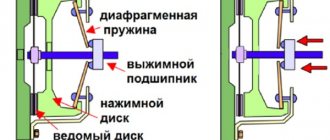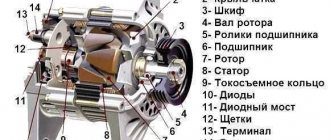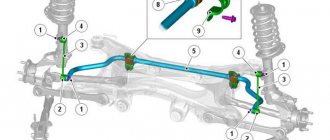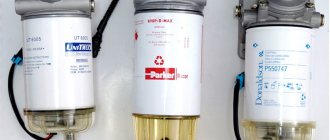The battery is subject to natural wear and tear as a result of boiling off of the electrolyte, sulfation and destruction of the active plates. Under normal operating conditions, these processes occur slowly and the batteries serve in cars 3–5 years.
With rare short trips, additional load and without timely maintenance, the battery life is reduced, which leads to a drop in capacity, starting current and the inability to start the engine. Most often, problems appear in the cold season due to an increase in the load on the battery and a decrease in its charging efficiency.
We'll tell you in this article how a car battery dies, what signs indicate this, and how to understand when it's time to change the battery in your car.
The main sign that it is time to change the battery in a car is a rapid drop in voltage even under light load while parked (provided that the current consumption in this mode is within normal limits - no higher than 80 mA). Even if the voltage of a dead battery was raised to 12.7 V using a charger, but after installing it on the car and parking it for more than 12 hours, it drops again to 12.5 or lower - change it. Otherwise, at some point (often on a frosty morning) you will not be able to start the engine. But there are other indicators and tests that will help determine whether it is worth buying a new battery.
Symptoms of a dying battery - when to look under the hood
Signs of battery wear on a car usually appear most clearly when the engine starts and when the load on the on-board network increases . Some of them may indicate either the exhaustion of the battery life itself, or simply a drop in the charge level due to a malfunction of the generator or increased energy consumption caused by improper operation of the equipment.
The main symptoms of a dying car battery:
Symptoms of a tired battery using the example of Lada Vesta: video
- the starter has difficulty moving the flywheel, especially at low temperatures, the speed clearly slows down when the key or start button is held for more than 2-3 seconds;
- The brightness of the headlight lamps and interior lighting drops significantly when the engine is turned off, and after the start it increases abruptly;
- the battery goes to zero after 12 hours of parking;
- The idle speed drops when additional consumers are turned on, and when the air conditioner is turned on, the engine sometimes stalls;
- turning on the consumer (dimensions and headlights, audio system, compressor for inflating wheels) while parked with the engine turned off causes a noticeable drop in battery voltage;
- When the engine is off, the windshield wipers, windows and power sunroof move too slowly and with difficulty.
If you notice the symptoms described, you need to look under the hood and inspect the battery . The obvious signs of battery failure and their causes are listed in the next section.
Physical damage
The reason for replacing the battery is its physical damage. I have often seen cars in which the batteries under the hood are not secured, crawl back and forth across the site and jump on bumps. It is no wonder that over time cracks appear on their body. External damage means that not everything is in order inside the battery: from destruction of contacts, terminals, lead plates to leakage of electrolyte. The electrolyte, by the way, is a battery component that is dangerous for the car body - it is an acid solution that quickly destroys the paint and protective coating of the metal, creating a favorable environment for corrosion.
Under no circumstances should a used battery be thrown into a regular trash container; it must be submitted for recycling. This is also done by companies that sell batteries. When you return your old battery, they will also give you a discount on a new one.
It's not just cracks that are terrible for the battery. She may well swell. This occurs due to suboptimal conditions for chemical reactions inside. The main reason is temperature.
- When overheating occurs inside the battery, excessive gas formation occurs, which swells the housing.
- In severe frosts, the electrolyte hardens and deforms the housing.
A swollen battery should not be used.
Signs and causes of a dying car battery
A battery that has exhausted its resource may fail at any time. In addition to the fact that the car may not start when it gets cold or after several short trips, the battery case may be destroyed with electrolyte leaking, failures in the on-board electronics due to voltage surges, etc. In addition, the load on the generator increases . Having noticed signs of a dying battery, you need to take measures to eliminate the causes of their appearance, and then charge the battery or replace it.
Signs of a dying car battery and their causes:
| Battery problem | Why is this happening | What to do |
| Battery drains quickly |
|
|
| Gray light coating on the plates | Deep charge or non-optimal battery charging mode. | Carry out charging with desulfation of the battery or replace the battery. |
| The body is swollen (without damage) |
|
|
| Cracks and leaks on the battery case |
| Replace the battery. |
| Low voltage and electrolyte density after charging | Sulfur from the electrolyte turns into lead sulfate and settles on the plates, but cannot dissolve back due to excessive crystal formation, so the density of the electrolyte decreases. It is also possible that the electrolyte may boil away. | Charge the battery and adjust the electrolyte density. If it doesn’t help, change the battery. |
| Electrolyte is dark or has sediment | Destruction of the active mass of the plates or the formation of insoluble sulfate. | The battery requires replacement as it cannot be restored. |
| Plaque on battery terminals | Electrolyte boils off during charging due to sulfation of the battery. | Add distilled water, charge with desulfation, if that doesn’t help, change the battery. |
The service life of the battery depends on its type:
- ordinary lead antimony and low antimony - about 3–4 years;
- hybrid and calcium - about 4–5 years;
- AGM – 5 years;
- gel (GEL) – 5–10 years.
Signs of deterioration of the car battery may appear earlier with short miles, frequent starts, a large number of additional equipment, for example, an aftermarket multimedia system with amplifiers and speakers of higher power, or malfunctions that lead to insufficient charging or over-discharging. At the same time, in good conditions and with timely maintenance, the battery can last 1.5–2 times longer than expected.
Time required to replace the battery in a car
Remember that if a car starts poorly in cold weather, but works well in summer, then this is still wrong. The reliable battery copes with work in any weather.
A car owner may be unpleasantly surprised when he sees the battery completely frozen during one of the winter periods. This phenomenon is based on the fact that during prolonged work on the plates, plaque forms inside it. It does not move back into the liquid (electrolyte), and, therefore, the density of the product becomes significantly less.
Next, ice forms inside the battery case (due to decreased freezing of the liquid). In a situation where the electrolyte freezes, the plates that make up the product begin to deteriorate, which means that the period for the battery to fail to function has arrived.
In addition to this (why it is necessary to replace the battery in the fall), it is also necessary to remember that in winter, electricity consumption increases. Various types of lighting devices greatly influence this. This is especially noticeable in the northern latitudes, where there is polar night.
The next significant step in warning about replacing the battery in the autumn period is that in winter there is icy conditions, which means you won’t go far at high engine speeds.
At such times, the vehicle’s generator is usually turned off, which means that the entire enormous load will fall on the battery, which is already barely breathing.
How to check if the battery needs to be replaced
The only clear indications of the need to replace a car battery are damage to the case, destruction or short circuit of the plates. Otherwise, you can try to extend the battery life by trying to charge it and testing it. To make a preliminary assessment of the wear of a car battery before testing, you need to:
- Measure voltage
.
On a working battery with a normal residual life, it should be no lower than 12.6 V
when measured 3 hours after charging.
Lower values indicate critical wear, and if the voltage does not reach 11 V
, then there is
a possibility of a short circuit
in one of the cells. - Check the density of the electrolyte
.
Normally, on a serviceable, charged battery, it should be about 1.27–1.28 g/cm3
at room temperature. You can also check the density on a discharged battery, but then to assess its condition you need to compare the obtained values with the tabulated ones. The normal dependence of density on temperature and charge is shown in the illustration. - Check electrolyte level
.
Normally, the electrolyte should have a level 1.5–2 cm above the edge
of the plates. Many batteries have level marks inside the service holes; in some models it is displayed using a float indicator. If the level is below normal, it can be restored with distilled water. - Check sulfation
.
In serviceable batteries with plugs, by unscrewing them, you can visually inspect the plates. Ideally, in a charged state, they should not have a light gray coating
, a small amount is acceptable, but deposits over most of the area indicate a high degree of wear on the car battery.
You can reliably identify the wear of car batteries using diagnostic equipment or tests.
Test 1: Normal load test
It is not always possible to find out the remaining life of a battery only by external signs and voltage. A more correct approach is load testing. The easiest way to identify a dying battery is to load it with standard electrical appliances. For the test you need:
- After recharging or a long trip, wait 1–2 hours until the voltage on the battery normalizes.
- Turn on the headlights.
- Wait about 30 minutes.
- Start the engine again.
If the battery is still in good condition and the engine is in order, then it will start on the first try, the starter will turn vigorously. If the battery is worn out, starting will be difficult (or completely impossible) and you should hear the starter working “in tension”, its speed sags.
Test 2: Load Fork Test
You can quickly determine that it is time to change the battery using a load fork. The test is carried out on a charged battery in the following order:
Battery test with a load fork: video
- Connect the load plug with the unloaded terminal and measure the open circuit voltage (OCV).
- Connect the load plug with the second terminal and measure the voltage under load with a high current.
- Keep the plug connected for about 5 seconds and monitor the voltage changes on its scale or screen.
In good condition, a charged battery should produce 12.6–13 V without load. After connecting the plug, the voltage will drop and the degree of wear can be approximately assessed by the amount of drawdown. On a fully operational 55–75 A*h car battery, there should be a drop of at least 10.5–11 V.
If the battery is “tired”, but still suitable for work, then the voltage in the load will be 9.5–10.5 V. If the values fall below 9 V, then such a battery will soon have to be replaced.
The nature of the change in readings is the second indicator of wear. If under load the voltage on the device is stable or even increases slightly, then the battery is working. A constant decrease in voltage indicates that the battery is already worn out and cannot support the load.
Test 3: Load capacitance measurement
Battery capacity is measured in Ah and is indicated on the battery. This value is obtained by discharging the battery with a load of 0.05C or 5% of the rated capacity, that is, 2.5 A for 50 Ah or 5 A for 100 Ah. It is necessary to charge the battery, and then proceed in the following order:
- Measure the NRC of a battery that has been charged and left for several hours.
- Connect a load of appropriate power of 0.05C (for a car battery, a 12 V light bulb up to 30–40 W is suitable).
- Leave the battery under load for 5 hours.
- Disconnect the load, wait a few minutes for the NRC to stabilize and measure it to assess the degree of charge of the battery by voltage.
- Determine the discharge percentage. For example, if the battery voltage level is 70%, then a fully charged battery is discharged by 30%.
- Calculate the residual capacity using the formula Res.=(load in A)*(time in hours)*100/(percentage of discharge).
If the battery is discharged to a voltage below 11.5 V at this stage, the result is already clear: its resource is exhausted!
If the lamp consumes 3.3 A, and a battery with a capacity of 60-65 A_h is discharged by 40% in 5 hours, then Comp. = 3.3_5_100/40 = 41.25 A_h, which indicates the presence of noticeable, but still acceptable wear. Such a battery will work, but starting difficulties may occur only in severe frost.
In some cases, the battery capacity, which has fallen due to sulfation of the plates, can be slightly increased using several charge-discharge cycles with low current or in pulse mode, available in a number of models of automatic chargers.
Test 4: Internal Resistance Measurement
Another way to understand that a car battery is dying is to measure the internal resistance of the battery.
Checking the battery with a professional Fluke BT510
This can be done by direct and indirect methods:
- Straight
. A special tester is used, amateur (for example, YR1035) or professional (for example, Fluke BT510), which directly indicates the value of internal resistance. - Indirect
. The amount of internal resistance is determined by the voltage drop at a known load.
A serviceable and charged lead-acid battery, when tested with a tester, should show an internal resistance of about 3–7 mOhm (0.003-0.007 Ohm). The larger the capacity, the lower the value should be. A doubling of the value indicates that the resource has been depleted by approximately 50%.
To indirectly calculate resistance, you will need a multimeter or voltmeter and a load with a known current consumption. A 60W car bulb is best.
How to check battery life by calculating resistance:
- The NRC is measured on a charged and cooled battery.
- A load is connected to the battery and held until the voltage stabilizes - usually about a minute.
- The battery voltage under load is measured.
- The magnitude of the drop in the NRC (ΔU) is calculated.
- The resulting ΔU value is divided by the load current (I) (5 A for a 60 W lamp) to obtain the resistance value using the formula Rpr.=ΔU/ΔI. ΔI will be equal to 5 A for a 60 W lamp.
- The theoretical internal resistance of the battery is calculated by dividing its rated voltage by the specified starting current using the formula Rtheor.=U/I.
- The theoretical value is compared with the practical value and the condition of the battery is determined from their difference. If the battery is working properly, then the lag between the actual result and the theoretical one will be small.
If the voltage drops sharply below 12 V, does not stabilize and constantly decreases even under light load, the wear of the battery is already obvious even without further tests.
Calculation of internal battery resistance: video
For example, let’s take a 60 A*h battery with a starting current of 600 A, charged to 12.7 V. Its theoretical resistance Rtheor.=12.7/600=0.021 Ohm or 21 mOhm.
If before the NRC it was 12.7 V, and when measuring after the load - 12.5 V, in the example it will look like this: Rpr.=(12.7-12.5)/5=0.04 Ohm or 40 mOhm . Based on the measurement results, it is possible to calculate the starting current of the battery, taking into account wear according to Ohm’s law, that is, I = 12.7/0.04 = 317.5 A (from the factory 600 A)
If before the measurements the voltage was 12.65 V, and after - 12.55, then Rpr. = (12.65-12.55)/5 = 0.02 Ohm or 20 mOhm. This converges with the theoretical 21 mOhm, and according to Ohm’s law we get I = 12.67/0.021 = 604 A, that is, the battery is in ideal condition.
Another way to calculate the internal resistance of a battery is by measuring its voltage at two different loads. It is presented on video.
Answers to frequently asked questions
How can you tell if your battery is old?
You can determine that a battery is very worn out by 4 signs:
- The battery service life exceeds 5 years (the release date is indicated on the cover);
the engine starts with difficulty even in warm weather, a drop in starter speed is felt;
- the on-board computer constantly indicates the need to charge the battery;
- 3 hours of parking with the lights on and the engine off is enough for the engine to start with great difficulty or not start at all.
What are the signs that it’s time to change the battery in your car?
Critical wear of a car battery is indicated by:
- high charging and discharging speed;
increased internal resistance;
How to check battery suitability?
You can quickly check the suitability of the battery using a load fork. The voltage under load should not fall below 9 V. A more reliable test is carried out by measuring the internal resistance using special instruments or the applied load and comparing the actual value with the reference value.
The engine starts with difficulty or does not start at all
The key is to start, but instead of the usual chirping of the starter there are sounds like a series of clicks? Yes, this is another potential symptom of a dead battery. Although there may actually be several reasons for such behavior:
- The battery could simply be dead: if you forgot to turn off the lights in the cabin, for example, or the car sat motionless for several months. In this case, the battery can be charged; fortunately, there are now many chargers on the market for every taste and budget (from 5–25 thousand tenge).
- The terminal is oxidized or not tightened. It’s even simpler: just go over it with fine-grained sandpaper, clean the contact, blow it out, degrease it and tighten it or change the terminal.











